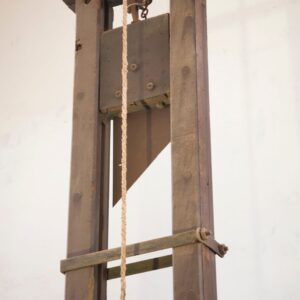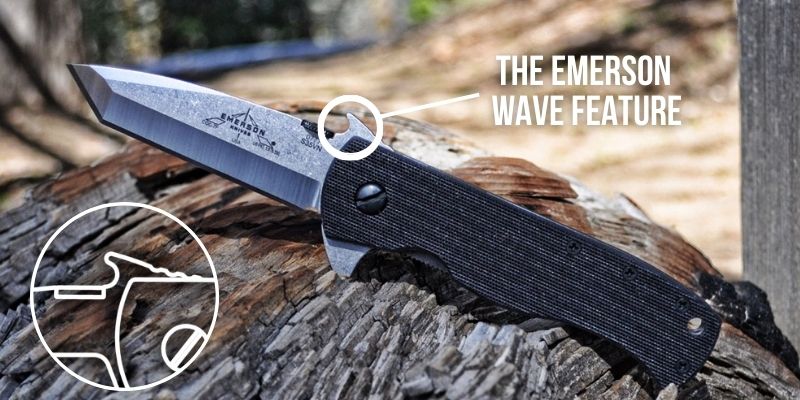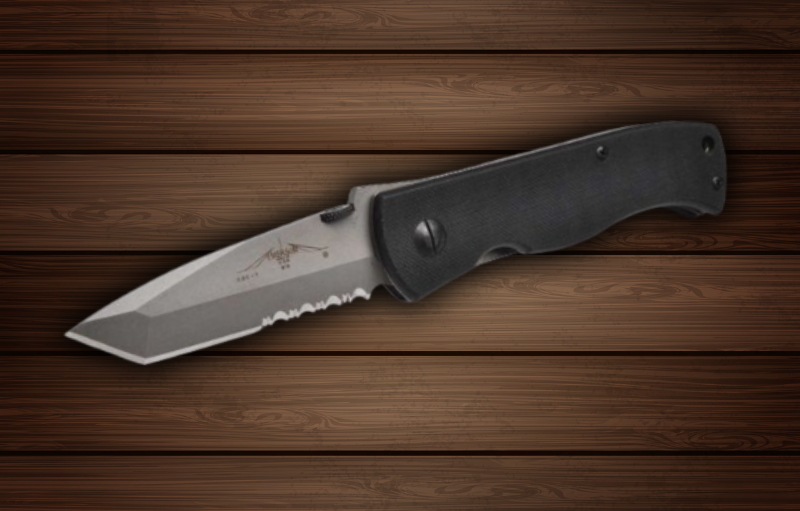In the last installment we discussed the Design Concepts behind the design of the CQC-7 Model.
So now let’s get on with the mechanics of the CQC-7 Knife Blade Design.
One of the requirements of the blade was that it needed to penetrate Kevlar and soft body armor. Being quite familiar with the characteristics of Kevlar and how and why it works, we knew it can stop a bullet, but it can't stop an ice pick. The larger the cross-sectional mass of the striking object, the greater the dissipation or spreading out of the force from the stripe due to the way Kevlar is constructed. Also, we all know that Kevlar is very tough and resistant to any slicing motion or cutting action. So how was I going to address that? Well, let's take a look at the guillotine as an example.

You'll notice that the cutting edge of the guillotine always has an angle to it, as opposed to being a straight, edge and parallel to the ground, which would result in a straight chopping action like an axe. The angle on a guillotine blade creates two cutting actions all in one motion. It shears (chops) and slices (cuts) as it engages, all at the same time. So, in regard to Kevlar, the chisel ground tanto point gives us this, a needle type point to accomplish initial penetration, then following the point, the angled edge of the tanto shears and slices the fibers as the remaining angle of the leading edge of the blade is forced in. It pierces, shears and cuts all at the same time as it is pushed through the material, and that is why it could defeat Kevlar.
Another new design feature I added to the cutting edge (the sharpened portion of any blade) was a secondary bevel that forms the actual sharpened edge of the CQC-7 Tanto. Now, as you know, a true chisel has one bevel that runs completely down to an infinite edge. And as a woodworker, I know how well a sharp chisel can cut. I also know how hard it is to properly sharpen a chisel. And believe me, over the years I've seen more chisels ruined by carpenters than I have seen properly sharpened. So, knowing that is the reason why I introduced the Emerson modified chiseled edge. After all, it actually is the way most wood chisels end up on the benches of most carpenters anyway.
This means that the Emerson chisel grind is not actually a true chisel grind, but a modified chisel grind, and there is good reason for this.
As a combat instructor, there's a universal principle that most instructors aren't even aware of. Most of them are so self-impressed with their own lifetime of practice and skillsets that they don't realize that most of their trainees are not lifetime devotees. And for many of their students, their only training may be in the few hours that they spend in a class or a seminar.
This foundational principle was stressed upon me by one of the top shooting instructors in the entire world, and what he impressed upon me was this. “Ernest, remember this always, you're not there to impress people. You are there to teach them. If they can't use your techniques with a minimum of instruction and if what you are teaching is not designed to work for ‘the average man', then you're not doing your job. It's a moral and ethical imperative. If you are teaching things that people are going to depend on to save their lives or the lives of teammates, innocence or loved ones in a time of need, then you better check your ego at the door.” Well, his advice became the foundation of everything I teach, and of course, it bled over into the reasons and ways that I designed my knives, specifically the tactical designs. (As you know, we do make some non-tactical and small pocketknives and of course kitchen knives.).

So, the reason for the single-sided sharpened edge bevel on the CQC-7 style blade was done so that anyone could bring their knife back to serviceable sharpness with whatever was at hand. Since you only have one edge to deal with (the other side being flat), you then could use a rock, a pipe, or even a piece of broken glass or broken flowerpot to bring an edge back to at least a minimum cutting sharpness so you could still use your knife. When you are behind enemy lines, you don't have the luxury of carrying around sharpening stones and sharpening gadgets. That's for back at the base. So, this edge geometry was designed based upon that principle so that the “average man” could sharpen his knife easily with little to no experience. Of course, you still can sharpen them to a hair-splitting razor sharpness if you care to on your own time.
The CQC-7 Wave.
The CQC-7 was the second model that we introduced with the Emerson Wave Feature, the first being our Commander model. And yes, that too is another story for another campfire tail.

As you know, the Wave allows you to deploy -open the knife- as it is withdrawn from your pocket, another Emerson innovation that has been imitated or outright copied by knife makers and knife companies all over the world. And as a funny side note to this, I've actually been accused by some of copying or stealing the Wave from other knife makers or knife companies that had actually copied the Wave from us, a design feature that I held the patent for 12 years. We still own a registered trade dress on the Wave Feature, which has no expiration date. Man, these younger generations just don't know their history.
So, you can see the Emerson CQC-7 was not a knife design created just to look cool. It was in its time a state-of-the-art tactical cutting tool, a knife design that broke the old rules and created and ruled the entire tactical genre for the entire cutlery industry.
It's been used and abused by hundreds of thousands of users all over the planet Earth in every environment and theater of combat, from jungle to desert and from the field of battle to construction sites for over 25 years, and we still can't make enough of them to satisfy the demand.
If so many people have used them successfully for every conceivable task, why were there still those that did not like the CQC-7 knife?
In the next installment, I'll discuss the love hate relationship that existed with the Emerson CQC-7.


I am enjoying this article very much. Really looking forward to the next installment. Love your knives.. Santa (me) brought me a new one for Christmas
I have a CQC-7 made by whose name stars with a B. I was an outdoors writer at the time and requested a knife to review from that company. Their PR guy called me and said one was on the way and he had included another knife too. Said it was kind of unusual in a, good way. He was very excited about it. . Well when I opened up the box, I said dang what heck is this! I was not sure I was onboard with the Emerson CQC-7. Well thsy wanted my feedback on it. So I shoved it in my pocket and gave it ago. Wow. I was wrong, I loved it and still do. Siting on my desk as I write this. Oh, the knife designed by the other company, never used it.
I have a CQC-7 made by whose name stars with a B. I was an outdoors writer at the time and requested a knife to review from that company. Their PR guy called me and said one was on the way and he had included another knife too. Said it was kind of unusual in a, good way. He was very excited about it. . Well when I opened up the box, I said dang what heck is this! I was not sure I was onboard with the Emerson CQC-7. Well thsy wanted my feedback on it. So I shoved it in my pocket and gave it ago. Wow. I was wrong, I loved it and still do. Siting on my desk as I write this. Oh, the knife designed by the other company, never used it.
Great read! Keep them coming!
I have one of the original knives. Love it.
While visiting Hawaii I was attacked by a “mob”of young adults. I was able to deploy my CQC 7 and save my life. The police later told me their were 16 attackers caught on video attempting to assault me. I will never be without a CQC 7 with me. I own 3 now.
Just waiting on a right hand grind cqc 7 waveless.
Me too.